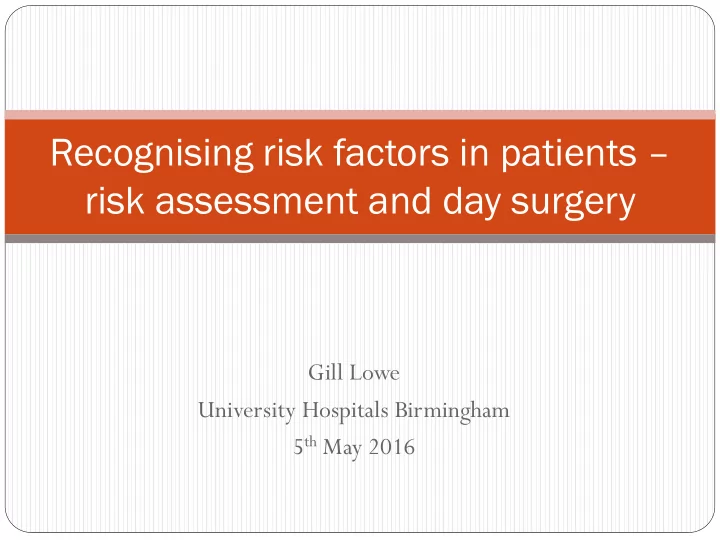

Recognising risk factors in patients – risk assessment and day surgery Gill Lowe University Hospitals Birmingham 5 th May 2016
Declarations Honoraria (advisory committee) and educational grant to attend meeting: Bayer PLC
VTE facts and figures Estimated to kill in excess of 25000 patients per year Commonest cause of hospital mortality Mortality rate around 30% untreated, falls to 2-8% with appropriate treatment Direct and indirect costs estimated at £640 million in 2005 2007 CMO recommendation – Individualised risk assessment for each hospital in patient Adopted by one third of acute trusts when audited in same year http://www.publications.parliament.uk/pa/cm200405/cmselect/cmhealth/99/99.pdf http://www.publications.parliament.uk/pa/cm200708/cmselect/cmhealth/1137/1137we16.htm#note127
Risk assessment Risk assessment and use of thromboprophylaxis proven to reduce mortality ( Collins R et al New England Journal of Medicine; 318: 18, 1162-73) Previous concerns related to inconsistent risk assessments and prescription of thromboprophylaxis following risk assessment (Rashid ST et al Journal of the Royal Society of Medicine 98 (11): 507–12) Currently nationally mandated quality requirement, including root cause analysis of all hospital acquired venous thromboembolic events (previous CQUIN) NICE guidance 2010 (CG92) – Venous thromboembolism: Reducing the risk for patients in hospital (addendum in 2015)
CG92 recommendations – VTE and Bleeding Risks Assess all patients on admission For medical patients, regard as increased risk if mobility significantly reduced for three days or more, or if they are expected to have ongoing reduced mobility and have an additional risk factor (see next slide) For surgical / trauma patients, regard as increased risk if: They have one or more identified risk factors (see next slide) Expected significant reduction in mobility Acute surgical admission with inflammatory or intra-abdominal condition Surgical procedure with a total anaesthetic and surgical time of more than 90 minutes, or 60 minutes if the surgery involves the pelvis or lower limb
CG92 recommendations – VTE and Bleeding Risks Assess bleeding risk in all patients Do not offer thromboprophylaxis to patients with any of the identified bleeding risks, unless the risk of VTE outweighs the risk of bleeding Reassess patients’ risk of bleeding and thrombosis within 24 hours of admission, and whenever the clinical situation changes
CG92 recommendations – Minimise VTE risks Do not allow patients to become dehydrated Encourage early mobilisation Antiplatelet agents are inadequate VTE prophylaxis Consider use of IVC filters in those at very high risk of thrombosis in whom mechanical and pharmacological prophylaxis is contraindicated
Example risk assessment
Recurrent issues Assessment of reduced mobility in medical inpatients Thromboprophylaxis failure becoming more prominent Delay in starting enoxaparin post admission Obtaining feedback from responsible medical team
Day case surgery Meta-analysis of 14 studies and just under 5000 patients – weighted rate of major VTE approx 3%, with two thirds risk reduction with use of thromboprophylaxis (Chapelle C et al Arthroscopy. 2014 Aug;30(8):987-96) Canadian study of 1200 patients with lower limb immobilisation - <1% rate of symptomatic venous thromboembolism and no role for routine anticoagulant prophylaxis (Selby R et al J Bone Joint Surg Am. 2014 May 21;96(10):e83)
Day case surgery Low risk procedures “block assessed” – other procedures require risk assessment Recommendations for enoxaparin prescription: Ongoing significant immobility – especially after lower limb or abdominal surgery and additional risk factors for VTE Previous VTE On the Oestrogen containing contraceptive pill or oral HRT if not stopped At discretion of surgeon or anaesthetist
Example cases Young female patient on contraceptive pill having day case arthroscopy Presented with leg swelling on same side as procedure Multiple attendances and delayed diagnosis Subsequent PE and ongoing shortness of breath 65 year old man having day case glaucoma surgery who presented with VTE shortly afterwards Not risk assessed as this procedure “low risk” On questioning, had been advised to undertake posturing, and developed gastroenteritis and dehydration shortly afterwards
Results from national programme Increased percentage of risk assessed patients from 45% in 2010 to >95% in 2013 Over this time period ONS data showed a reduction in VTE related deaths Significant reduction in hospital associated thrombosis observed following sustained achievement of >90% risk assessment at King’s College Hospital Associated significant fall in proportion of HAT attributable to inadequate thromboprophylaxis Extrapolation of this data estimated 900 potential lives saved in England per year https://www.england.nhs.uk/wp-content/uploads/2014/02/rm-fs-10-3.pdf Roberts, LN et al Chest. 2013;144(4):1276-1281
Increasing awareness Risk assessment process Root cause analysis and seeking feedback Patient information leaflets and education from nursing team Video on bedside screens
Conclusions Venous thromboembolism (and bleeding risk) risk assessment is mandatory for all patients admitted to hospital Appropriate use of thromboprophylaxis following risk assessment has been proven to be life saving Documentation and audit trail are very important Mandatory assessement of VTE risk has reduced rates of hospital acquired thrombosis and increases prescription of thromboprophylaxis Root cause analyses help to identify learning points and refine process Universal thromboprophylaxis in day case surgery is controversial, but risk assessment should be undertaken with consideration of thromboprophylaxis in higher risk patients
Thank you
Recommend
More recommend